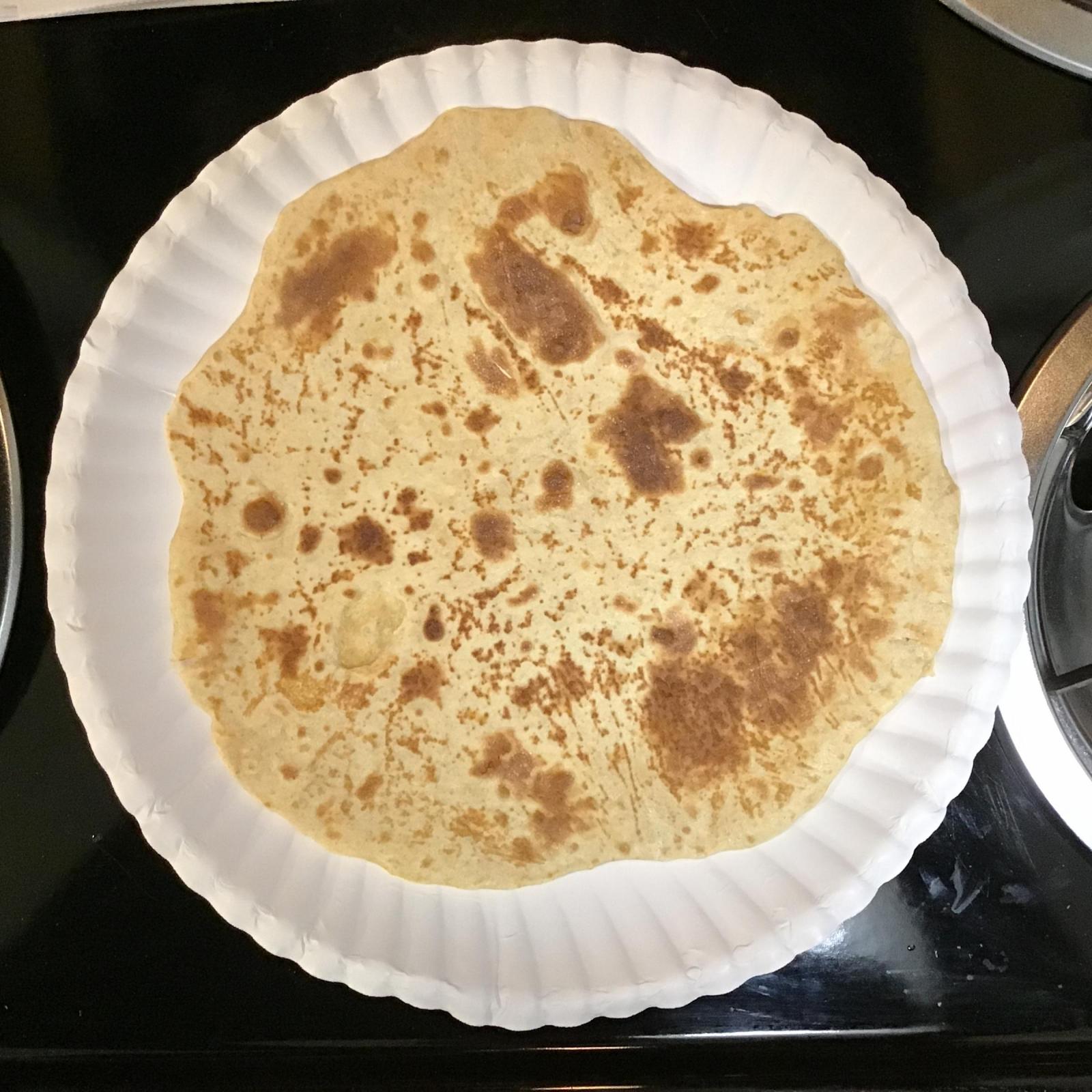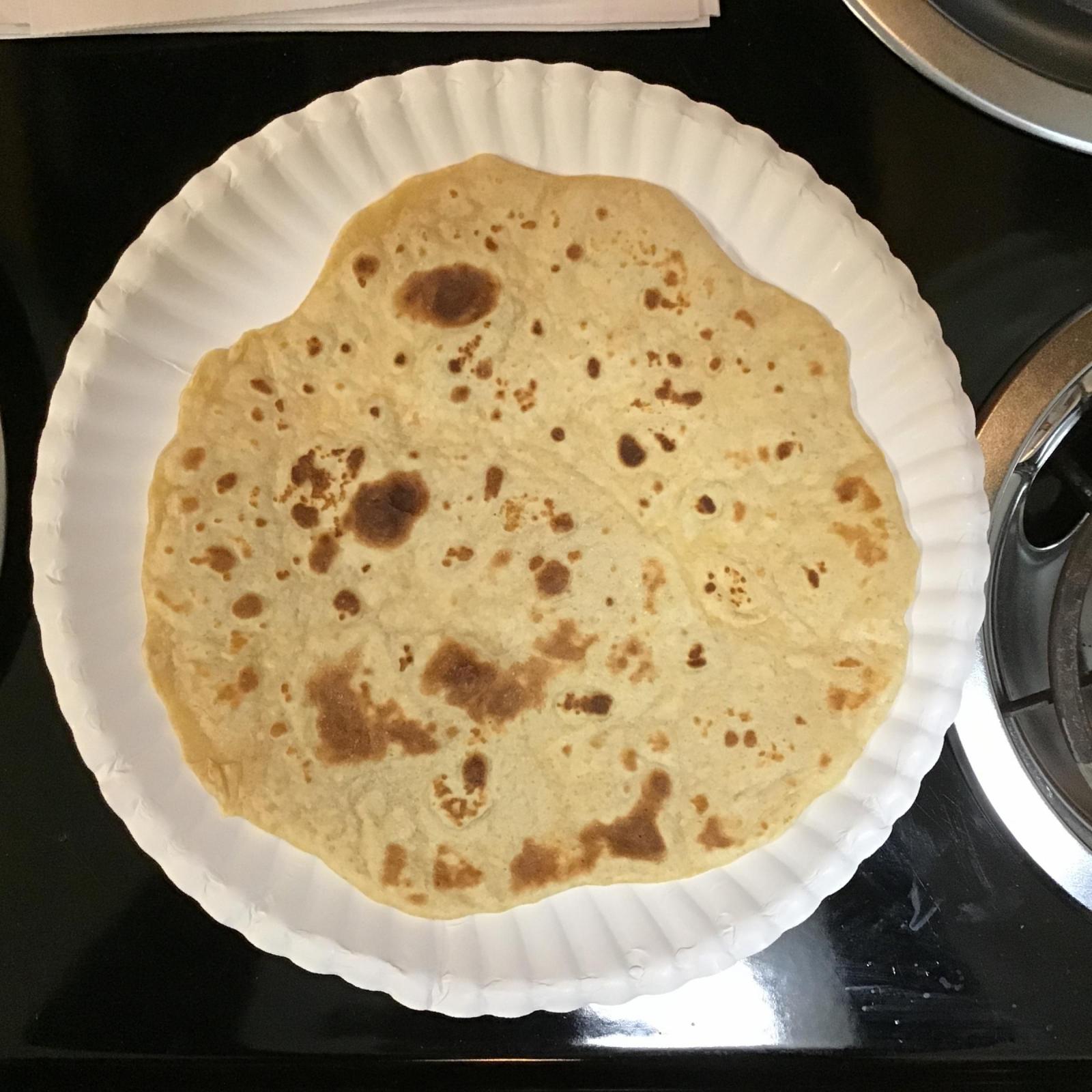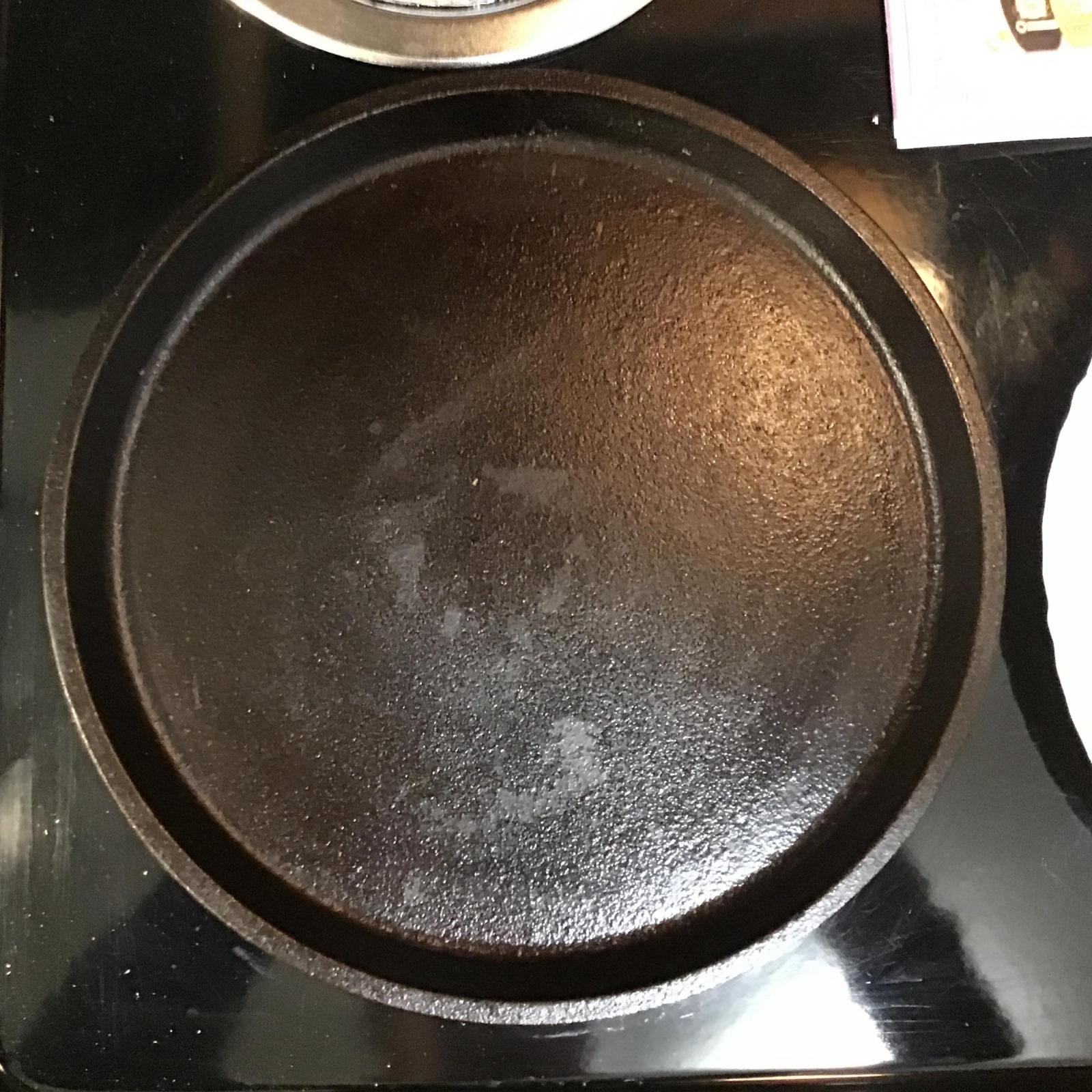Feb. 15, 2021.
This is bake #7 in the durum Community Bake. Previous bakes, #4, 5, and 6 are at: www.thefreshloaf.com/node/67434/bakes-381-382-383
- Whole grain durum flour, Sher Fiber Wala from Brar Mills, 100%.
- 77% water, room temp 70 F.
- 2% salt. (store-bought tortillas usually have more salt than this)
Mix and then knead a few minutes until mostly smooth.
Let rest at least 60 minutes. Durum takes a while to absorb water.
Knead for a few more seconds.
Separate/weigh-out a 62 gram piece of dough.
I use a center-bulge wooden rolling pin. Straight cylinder rolling pins tend to make square dough pieces when I used them.
I put a few drops of grapeseed oil on the rolling pin and spread it around on the pin, so it won't stick to the dough. And it imparts just the right amount of oil to the dough.
I roll the dough and rotate it 90 degrees, doing that 4 times, then flip and repeat, until it makes a rough circle 8" in diameter.
I cook on a Lodge cast iron 9.25" diameter griddle. If you don't oil the rolling pin, spread 2 or 3 drops of oil on the griddle and spread it with a paper towel.
The griddle is pre-heated at setting 3 or 3.5 out of 10 on my electric stove-top burner.
I cook the first side only 30 seconds, to set it, then flip. Then I cook the second side until it is has the right amount of brown spots, pressing down with a spatula all around so it cooks evenly, because it will inflate. Then I flip it back to the first side, and finish cooking it, again pressing all around with a metal spatula.
If you don't eat it immediately, put it in a "tortilla keeper" container, or wrap in aluminum foil, or let cool a few seconds and put it in a sealable plastic bag. This is so the inner moisture migrates out and softens the surface.
You should not cook it until the skin is crispy, but it will dry out if you don't enclose it in something. In a few minutes, the tortilla/chapati will be soft and flexible.
--
Submitted to the durum Community Bake here: www.thefreshloaf.com/comment/481587#comment-481587
The paper plate in the photos is 9" in diameter.



Next bake, #8 for the durum Community Bake is at: www.thefreshloaf.com/node/67450/39th-bake-02162021-80-ww-durum-3-stage-hydration
- idaveindy's Blog
- Log in or register to post comments
Do you think home-milled durum flour can achieve the same result? I have a mill and two sieves that are too fine (#80) or too coarse (#12) for bread flour. Still waiting for other sieves to arrive. Meanwhile, I have an idea about using the sieves I have and my Vitamix to make some sort of durum flour that I can use, but haven't a concrete plan yet. Would appreciate any suggestions. Thx.
Yippee
I don't think i was able to make flatbreads, or any bread, from 100% coarse-milled kamut.
I always had to blend it with home-milled white/red spring/winter wheat, or store bought flour.
I forget, do you have the Vitamix "grains container", or are you using the regular container with pointy blades (like I am) ?
Thanks.
Yippee
Hi, Dave,
Say, I need semolina to coat a fine durum bread. If I grind the durum berries in the Vitamix, any suggestions on how I can make semolina and "extra fancy" durum flour from the same batch of berries. Thx.
Yippee
I haven't milled durum yet. I have milled Kamut brand khorasan, which I think is close.
You could sift to get the different particle sizes, but the thing is that Vitamixed Kamut flour doesn't break apart (separate) the bran from the endosperm very well. I don't know if the same problem would exist for durum, but I suspect so.
I suspect it's due to how a blender works differently than stone milling. In a stone mill, the grain gets sort of "rolled" and "pinched" between the two stones, and the bran gets sort of "peeled" or "pulled" off the endosperm, at least to some degree.
Whereas the Vitamix blades _impact_ (hit, strike, punch) and _cut_ the grain, with little or no action that pulls the bran off the endosperm. (The Nutrimill Classic and Plus are what are called "impact mills", which make a slightly different kind of flour than stone mills.)
(I'm intentionally writing for an international audience, so I'm including synonyms so that the correct sense of some words can be better understood.)
I'm also learning how WW durum is hard to work with compared to low bran (low extraction) durum. That bran makes a big difference. The problem is stickiness. And It appears to me that _absorption rates_ of the bran and the endosperm are very different.
If the durum bran absorbs too much water before the durum endosperm absorbs the water. the bran never releases it and stays in a glue state.
WW durum behaves very differently than WW red or white wheat. Durum (and khorasan) are "glassy", and break apart into translucent glass-like shards that absorb water slowly. Red and white wheat breaks apart into powder and absorb water faster.
In my tests, WW durum (I use store-bought durum) has to be no more than 25-33% of the flour in a leavened loaf-style bread. (100% Ww durum is fine for tortillas/chapatis).
And for leavened loaf-style bread (not tortilla/chapati) you have to do multiple hydrations (bassinage) of Ww durum to slowly approach desired hydration level so that the bran doesn't get too much water too fast and permanently turn to glue.
Once the durum bran turns to "super glue", I've never been able to salvage the dough, even by adding white/refined bread flour or regular (red/white) whole wheat. The leavened loaf comes out a brick, or a hard rubbery sponge.
Remember that Italian Altamura bread, and Alfanso's gorgeous durum baguettes are made with low bran (low extraction) durum, not WW durum.
"Durum semolina" is low bran. (Granted, it usually has a higher ash% than AP or bread flour, but is still relatively refined.)
--
Net: You're just going to have to experiment.
The information you provided is very helpful! I will design a plan to tackle the potential problems of whole-grain durum.
Yippee
.
Those look awesome! Will that work with other flours at similar hydration?
Durum flour is a different species, Triticum Durum, than regular American wheat, Triticum Aestivum.
And my 6 bakes, or 7 now, with this WW durum, shows WW durum is perhaps more different from refined (bran-less) durum, than regular WW flour is from regular white flour.
--
For chapatis, the only variable is water %, so It's easy to experiment. And this is normal, because every flour has it's unique hydration requirement.
Durum is odd, because it's not just the amount of water, but the timing of water additons. Not just add-then-wait, but add-wait-add-wait-add-wait --- like a bassinage, a double or triple addition.
Traditional tortillas have fat (oil or lard) and a chemical leavener (baking powder) which makes them stay soft longer.
So, as long as you don't try to store it, a chapati is as good as a tortilla _in the short run._
Got it and will experiment a bit... Understood on the shelf life, but this resolves my big issue... Want tacos for my wife and I... Need 3-4 soft shells... Have to buy a package of 10 and hope you have tacos again before they get stale in the refrigerator... :-)
I'm still enjoying the occasional Fiber Wala tortilla/chapati.
77% hydration, 2% salt also works with up to 5% oil. So far I've tried regular olive oil, grapeseed oil, and MCT oil (made from coconuts.)
Kroger had a close-out sale on some MCT oil for only $4.25 for 16 fl ounces, a very good price. This oil is thinner than regular coconut oil, and stays liquid at room temp.
Letting the dough rest overnight in the fridge made it very tender.
--
This Fiber Wala might not be 100% whole grain, but it does seem to have at least most all the bran based on how much water it takes.
The moisture made it puff up, so no chemical leavening (baking powder) is needed.